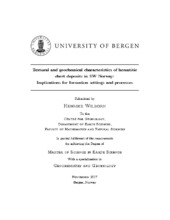Textural and geochemical characteristics of hematitic chert deposits in SW Norway: Implications for formation settings and processes
Master thesis
Permanent lenke
https://hdl.handle.net/1956/16970Utgivelsesdato
2017-11-30Metadata
Vis full innførselSamlinger
- Department of Earth Science [1034]
Sammendrag
Jasper, a specific type of hematitic chert, is often interpreted as an ancient analogue to modern seafloor hydrothermal deposits. Modern low-temperature seafloor hydrothermal Fe-deposits are mainly produced by Fe(II)- oxidising chemolithoautotrophs, which produce characteristic filamentous microstructures. Hematitic cherts from the SW Norwegian ophiolithic terrain exposed on the islands Stord and Bømlo have not been examined within the scope of this potential formation process. In this study, 10 hematitic chert samples were investigated to clarify the processes leading to their formation and if they all formed analogously to modern seafloor hydrothermal Fe-deposits. Additionally it was examined how the presence of hematitic cherts within the ophiolitic terrain can help to improve the understanding of the areas’ geological history. Geochemical, textural, and mineralogical analyses were conducted by applying inductively coupled plasma optical emission spectrometry, inductively coupled plasma mass spectrometry, optical microscopy, scanning electron microscopy, and Raman spectroscopy. Pronounced geochemical and textural differences were found, and four subtypes of hematitic chert were defined. Bedded hematitic radiolarian cherts (Lower/Middle Ordovician, Langevåg on Bømlo and Sagvåg on Stord) consist of SiO2 (~77 – 87 wt%), Al2O3 (~6 – 10 wt%), and Fe2O3 (~3- 6 wt%), and they have relatively high trace and rare earth element (REE) concentrations ( ΣREE ~30 – 66 ppm). Radiolarian shell remnants and distinct layering are present. A sampled hematitic radiolarian chert band (late Cambrian, Geitung by Bømlo) closely resembles the bedded cherts, but exhibits a much lower Al2O3 content, and significantly lower trace element contents and REE sum (2.8 ppm). Jasper (late Cambrian) differs vastly, no layering is present and Fe2O3 and SiO2 (~3- 23wt% and ~75 – 92 wt%, respectively) dominate, while Al2O3 is negligibly low. Trace element and REE concentrations are very low ( ΣREE ~1.1 - 3.0ppm). Two types of jasper can be distinguished. Abiogenic jasper (Geitung by Bømlo) is characterised by the absence of filaments, but contains hematite crystals occurring in concentrated clusters of polygonal patches, indicating a gel precursor undergoing syneresis. Microbially induced jasper (Finnås on Bømlo) contains a high abundance of hematite crystals comprising filamentous structures interpreted to be of microbial origin. This study demonstrates that the hematitic cherts on Stord and Bømlo have different formation processes. The hematitic radiolarian cherts are interpreted to have formed mainly from radiolarian ooze and terrigenous/volcaniclastic input. They clearly cannot be seen as analogues to modern Fe-deposits in seafloor hydrothermal systems. The abiogenic and microbially induced jaspers very likely originate from low-temperature hydrothermal fluids, emanating from the seafloor. The abiogenic jasper formation can be explained by diffusely venting fluids forming Fe-Si-oxyhydroxide gels, in which abiogenic precipitation took place. Temperatures were potentially too high for Fe(II)-oxidising chemolithoautotrophs to thrive, explaining the absence of filamentous structures. The microbially induced jasper is interpreted as having formed by diffuse venting leading to mound formation in which redox conditions and temperatures were favourable for Fe(II)-oxidisers, causing filament formation. This can potentially serve as an ancient analogue to modern hydrothermal Fe-deposits found in the Jan Mayen Vent Fields and several other vent fields. The bedded hematitic radiolarian cherts formed during the Lower/Middle Ordovician within a widening back-arc basin with suboxic seafloor conditions. Landmasses nearby provided terrigenous volcaniclastic input. The jaspers, both abiogenic and microbially induced, formed in the deep sea during the early stages of an immature island arc in the late Cambrian. The late Cambrian radiolarian chert band formed coevally, but during a quiescent phase and was potentially unaffected by hydrothermal fluids.
